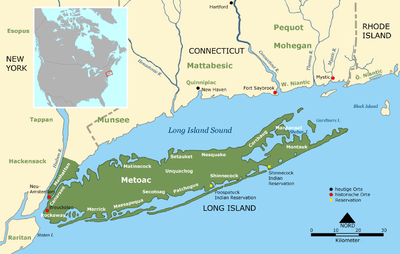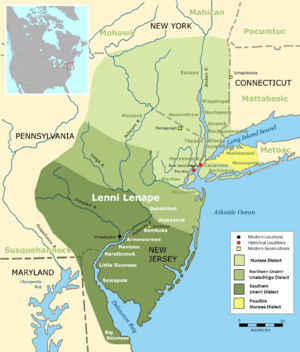Metoac
Metoac was a term erroneously used to describe Native Americans on Long Island in New York, in the belief that bands were distinct tribes of this location. The amateur anthropologist and U.S. Congressman Silas Wood published a book in the 19th century mistakenly claiming that several American Indian tribes were distinct to Long Island, New York. He collectively called them the Metoac. Scholars now understand that these historic peoples were part of three major cultural groups: the Lenape and the Wappinger-Wangunk-Quinnipiac peoples, both part of the Algonquian languages family.
Modern scientific scholarship has shown that Native American peoples on the island belonged to two major language and cultural groups among the Algonquian peoples who occupied Atlantic coastal areas from Canada through the American South. The bands in the western part of Long Island were related to those Algonquins which previously settled in the territory East of the Hudson river, related to peoples in what is now western Connecticut. Those to the east were more related culturally and linguistically to the Algonquian tribes of New England across Long Island Sound, such as the Pequot.[1][2] Wood (and earlier colonial settlers) often confused Indian place names, by which the bands were known, as the names for different "tribes" living there.
Wood may have derived his collective term from metau-hok, the Algonquian word for the rough periwinkle,[3] which played an important role in the economy of the region before and after the arrival of Europeans. Those entering western Long Island were mostly Dutch colonists, some from New Netherland. The eastern part of the island was colonized by English settlers from southern New England. Indigenous populations declined significantly within a few decades of European contact, due to diseases. Many of the place names given by the Lenape and Pequot populations are still in use today. The Shinnecock Indian Nation, based at what is now Southampton, New York in Suffolk County, has gained federal recognition as a tribe and has a reservation there.
Languages
The Native American population on Long Island has been estimated at 10,000 at the time of first contact.[4][5] They spoke two languages within the Algonquian language group, reflecting their different connections to mainland peoples.[6] Tribes in the west and in the central part of Long Island were in close relationship with Lenape, which occupied the territory on the western shore of the Hudson River and Wappinger, which lived on the eastern shore. This group of "Metoac" spoke one of the R-dialects, close to the language of Wappinger. However, it is worth noting tribes lived in and around what is now New York City, which were under very strong cultural influence of Lenape. Their dialect due to multiple contacts with speakers of L-dialects (Unami and Munsee) has acquired certain features typical for Lenape language. Finally, those lived on the east end of the island were related to the Pequot of eastern Connecticut, speaking a Y-dialect of the Mohegan-Montauk-Narragansett language.[2]
European colonization
European colonization of the region began in the 1620s. From the north the New England Confederation exerted influence on eastern Long Island and along its north shore. The western portion (including what are now the New York City boroughs of Brooklyn and Queens) were under the jurisdiction of New Netherland. This separation between zones of Dutch and English influence was formalized in their Treaty of Hartford in 1650, which set a border running south from Oyster Bay. The Native Americans on Long Island played an important role in the trade economy as shells harvested there fashioned into small beads to create sewant, or wampum ("wampompeag" - shortened later by the English) used to decorate ceremonial wear were the most highly prized.
Displacement
The Pequot War (1634–1638) in southern New England and Kieft's War (1643–1645) in the New York metropolitan area were two major conflicts between the indigenous peoples and the colonists. Exposure to new Eurasian infectious diseases, such as measles and smallpox, dramatically reduced the numbers of Native Americans on Long Island. In addition, some Native American settlements on Long Island migrated away under pressure from European settlement. By 1659, their population was reduced to less than 500.
After the American Revolutionary War, their numbers were reduced to 162 people by 1788. By this time, Samson Occom had persuaded many survivors to join the Brothertown Indians in western upstate New York, where the Oneida people of the Iroquois Confederacy shared their reservation for several years.
Exonyms
For generations, colonists mistakenly used the place names as exonyms for peoples, thinking they referred to tribes. Among the many locations on Long Island used by the native peoples, 19th-century American publications identified the following thirteen as "tribes" on Long Island:[7][8]
- Canarsie - in modern-day Brooklyn, New York and Maspeth, Queens, and Jamaica, New York. According to legend, the Carnarsee sold Manhattan to the Dutch Governor Peter Minuit for "24 dollars' worth of beads and trinkets.".[9]
- Corchaug (Cochaug)(Cutchogue) - around Riverhead and Southold, New York in eastern Long Island. The Fort Corchaug Archaeological Site is on the National Register of Historic Places.
- Manhasset (also known as Manhansick) - located on Shelter Island, New York. The city of Manhasset, New York was named for them.
- Marsapeague (also known as Massapequa, Marsapequa, Maspeth), - Located on the south shore, from the Rockaways east into Suffolk County. Massapequa and Maspeth, Queens are derivations of this.
- Matinecock (also known as Matinecoc) - Located on the Long Island North Shore from Flushing, Queens to Huntington.
- Mericoke (also known as Merrick, Meroke, Merikoke, Meracock) - Located on the south shore from the Rockaways into Suffolk County. Merrick is a derivation of this.
- Montaukett (also known as Montauk, Meanticut)- Located in East Hampton, New York. Its sagamore Wyandanch had his name on the title transfer of most of Long Island to the European settlers.
- Nissequaq (also known as Nesaquake, Missaquogue)- Located on the North Shore from Fresh Pond to Stony Brook in Suffolk County. The village of Nissequogue and the Nissequogue River are named after this.
- Rockaway (also known as Rechaweygh, Rechquaakie)- Located around Rockaway and portions of Jamaica and Maspeth The Rockaways is a place name derived from this.
- Secatague (also known as Secatoag, Secatogue) - Located at Islip on the south shore.
- Setauket (also known as Setalcott) - Located on the North Shore from Stony Brook to Wading River, New York. The village of Setauket is named after this.
- Shinnecock Indian Nation - Located in Southampton. The federally recognized tribe occupies the Shinnecock Reservation, New York.
- Unkechaug (also known as Patchogue, Onechechaug, Patchoag, Unchachaug, Unquaches, Unquachog, Unquachock, Unchechauge) - Located on the south shore from Brookhaven, New York to Southampton, New York.
State and federal recognition

At the end of 2009, the administration of President Barack Obama announced the Shinnecock Indian Nation had met the federal criteria for recognition as a tribe.[10] The Shinnecock were recognized by the United States government in October 2010 after a more than 30 year effort, which included suing the Department of Interior.[11] The Acting Principal Deputy Assistant Secretary of Indian Affairs, George T. Skibine issued the final determination of the tribe's recognized status on June 13, 2010.[12]
New York State has recognized the Shinnecock, based at Shinnecock Reservation near Southampton and the Unkechaugi, whose Poospatuck Reservation at Mastic is the smallest Indian reservation in the state. The Montaukett, a group around Montauk, is seeking both state and federal recognition.
References
- 1 2 3 Strong, John A. Algonquian Peoples of Long Island Heart of the Lakes Publishing (March 1997). ISBN 978-1-55787-148-0
- 1 2 3 4 Bragdon, Kathleen. The Columbia Guide to American Indians of the Northeast,Columbia University Press (2002). ISBN 978-0-231-11452-3.
- ↑ Ricky, D.B. (1998). Encyclopedia of Pennsylvania Indians. Somerset Publishers. ISBN 9780403097722. Retrieved 2015-04-14.
- ↑ longislandsoundstudy.net/about-the-sound/history/
- ↑ montaukclub.com/the-montauk-club/.../the-montauk-tribe/
- ↑ Barron, Donna. The Long Island Indians and Their New England Ancestors: Narragansett, Mohegan, Pequot & Wampanoag Tribes. AuthorHouse. June 28, 2006. ISBN 978-1-4259-3405-7
- ↑ Nathaniel Scudder, A History of Long Island From Its First Settlement By Europeans to the Year 1845, New York: 1845
- ↑ "Metoac Tribe". accessgenealogy.com. Retrieved 2015-04-14.
- ↑ Islands Draw Native American, Dutch, and English Settlement, City-data.com, Retrieved December 1, 2007]
- ↑ Hakim, Danny (2009-12-15). "U.S. Eases Way to Recognition for Shinnecock". New York Times. Retrieved 2009-12-17.
- ↑ Hakim, Danny (June 15, 2010). "U.S. Recognizes an Indian Tribe on Long Island, Clearing the Way for a Casino". The New York Times. Retrieved 2010-06-15.
- ↑ Darling, Nedra. "Skibine Issues a Final Determination to Acknowledge the Shinnecock Indian Nation of Long Island, NY. Office of the Assistant Secretary-Indian Affairs. 15 June 2010 (retrieved 12 July 2010)

